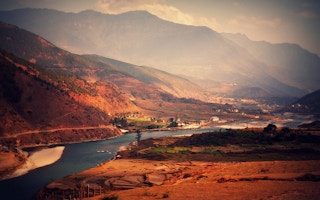Narendra Modi’s first foreign visit as Indian Prime Minister was to India’s small neighbour, Bhutan. One reason was strategic, with the landlocked Himalayan country lying on the border with China, just south of Tibet. The other was the large hydropower potential of Bhutan, which has been seen by India as a source of cheap electricity.
A win-win partnership?
Hydropower development in Bhutan has been the cornerstone of India-Bhutan cooperation. The model consists of India supporting Bhutan in building hydropower projects, by providing finance – a mix of grants and loans – and technical support to design and construct the projects.
Bhutan not only gets electricity for its own use, but also exports the surplus power to India, earning much needed revenue and foreign exchange. India gets relatively cheap power. Hydropower exports contribute around 40 per cent to Bhutan’s revenue and 25 per cent of its GDP.
For many decades, this has been seen as an ideal win-win arrangement, and there are plans to expand it massively. While Bhutan’s installed hydropower capacity in 2015 was 1,608 megawatts (MW), the 2006 India-Bhutan agreement on hydropower, with an additional protocol in 2009, stated that India would help Bhutan install 10,000 MW of hydro capacity by 2020, and purchase all the surplus power.
However, this model is now fraying at the edges, and threatens to unravel. When this author visited Bhutan in 2014, there were already voices of concern regarding the large upscaling of this model, questioning its economic and ecological efficacy.
Now, a new report brought out by Vasudha Foundation in New Delhi, “A Study of the India-Bhutan Energy Cooperation Agreements and the Implementation of Hydropower Projects in Bhutan”, not only reiterates and confirms these concerns, but provides detailed substantiation for them.
Declining economic benefits
One of the most important points made by the report is that economically and commercially, this model is making less and less sense.
The report notes that the Punatsangchhu I and II and the Mangdechhu projects are under construction, accounting for 2,940 MW of the total 10,000 MW to be generated. However, not only has the commissioning of the projects been delayed, but their costs have escalated massively. The cost of the 1,200 MW Punatsangchhu-I has gone from estimated BTN/INR* 34 billion (USD 510 million) to BTN/INR 97 billion (USD 1.46 billion).
For 1,020 MW Punatsangchhu –II project, the cost has gone to BTN/INR 74 billion (USD 1.1 billion) from BTN/INR 38 billion (USD 570 million) and for the 720 MW Mangdechhu to BTN/INR 45 billion (USD 675 million) from BTN/INR 29 billion (USD 435 million).
Moreover, the financing terms, whereby India would finance the entire project costs with a 60 per cent grant component and 40 per cent loan, have been reversed with loan component now comprising 60-70 per cent. Interest rates are also higher.
All this has affected the economics of the projects, and the report notes that, “The sector’s financial performance has however seen deterioration in the previous decade, indicating that its commercial profitability cannot be taken for granted.
Economic analysis has revealed that the net profit per unit of electricity sold has fallen sharply since 2007.” Moreover, hydropower has contributed to a steep rise in Bhutan’s debts, and the report notes Bhutan is “among 14 other countries that are fast heading towards a debt crisis.”
Thus, the hydropower program has lost a lot of its financial sheen.
Huge environmental impact, weak regulation, no jobs
At the same time the hydropower projects are also having massive environmental impacts. While the scale of hydropower development was low in the earlier decades, the projects now are bigger and more in number.
Case studies of six projects presented in the report note that major environmental impacts include, “loss of forest lands; disturbance to wildlife habitat; heavy dust pollution from construction work and use of heavy vehicles to transport construction material and equipment noise pollution due to blasting and tunnelling activities; damage to open water bodies such as streams and ponds; and severe stress on water resources in the region.”
Noting that much of the environmental information is not available for projects supported by India, the report notes that “there is a growing sense that the [Environmental Impact Assessment] EIA reports are poor and do not sufficiently assess impacts of projects”.
It also notes that the environmental assessments are done at a much later stage in the project cycle, which has “reduced regulatory processes, impact analysis, and consents and clearances from ministries to become inconsequential proceedings”.
It also notes that, “the National Environment Commission (NEC) …lacks the institutional capacity to discharge its responsibilities effectively given the scale of proposed hydropower development in Bhutan.”
The report also points out that the hydropower development has failed to build local capacities, with most of the contracts going to Indian companies.
At the macro-economic level, the report quotes the Eleventh Plan document of Bhutan which notes that, “lack of economic diversification has resulted in a situation of high growth rates driven by the hydropower sector without a commensurate increase in gainful employment for a rapidly growing and educated labour force, which poses significant macroeconomic challenges.”
In other words, this sector, that is responsible for the huge debt, is also not creating the right kind of jobs.
This story was published with permission from The Third Pole. Read the full story.










